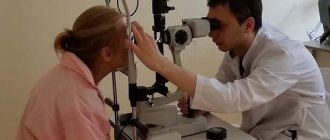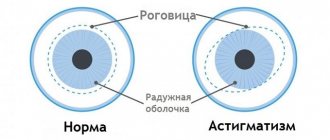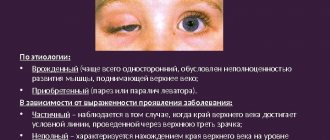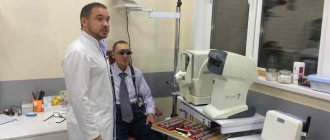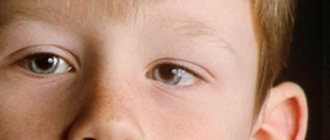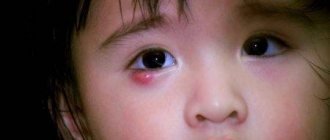Today, the phrase “computer vision syndrome” is increasingly being used by ophthalmologists. This condition refers to a painful phenomenon in which a person complains of decreased visual acuity and persistent eye fatigue. The patient begins to suffer from headaches, dryness, redness and other unpleasant symptoms. Computer vision syndrome can develop at different rates, which depends on the general condition of the body and the presence of concomitant diseases.
Why do my eyes get tired?
First, let's understand how the visual organs work and why they can get tired.
The eyeball contains muscles that are responsible for its movement. If you look at one point for a long time, as often happens when working at a computer, then these muscles begin to get tired, thereby provoking a spasm of accommodation. Among other things, all structures of the eye begin to tense up. This happens due to the fact that they begin to adapt to a certain level of screen illumination. If you work with spreadsheets in Excel, then most likely the monitor reflects white light, but if you watch movies, for example, thrillers, then dark fragments predominate on the screen. It is under this lighting that our visual organs begin to adapt, which requires increased muscle work. However, this is not the only reason for our eyes to become tired.
Light radiation, especially that coming from technology screens, also has a very negative effect. The fact is that it is artificial, and therefore poses a great danger to the organs of vision. Many people don't realize how dangerous glare from monitors and TV screens can be. In fact, they are often one of the main causes of retinal dysfunction. The other extreme, namely low lighting, is also dangerous for the health of the visual organs. Agree that each of us, at least once in our lives, read a book under a dim table lamp or worked on a laptop with the lights off. This is dangerous because under such conditions the pupil can expand greatly, trying to adjust to the level of lighting. The light emitted by headlights has a negative impact on the condition of the eyes and vision in general, especially if you drive a car at night.
Unilateral visual impairment
A decrease in visual acuity is fraught with its complete loss. It may decrease due to various diseases. For example, in connection with diseases of the optic nerve.
With obstruction of the retinal vessels, which more often occurs in people with high blood pressure and heart disease, unilateral partial or complete loss of vision may occur.
Another cause of unilateral decrease in acuity is hemorrhage in this eye. This can happen due to injury or pathology of the blood vessels of the eyeball, for example, with diabetes mellitus.
When optic neuritis is caused by infection, retinal detachment occurs, leading to unilateral visual impairment.
In what cases do doctors prescribe drops to restore vision?
Modern ophthalmologists recommend using eye drops to improve vision in cases where the patient complains of discomfort when wearing contact lenses, decreased visual acuity during visual work, and also when the eyes begin to get tired quickly. The listed factors may result from the following reasons:
- starting to use contact lenses, since the presence of a foreign body in the eyes may initially cause discomfort;
- prolonged work on a computer or other gadgets, as well as with any small parts;
- staying in rooms with air conditioning, as this is one of the causes of symptoms of “dry eye” syndrome;
- if the patient often depends on temperature changes. Bright rays of the sun or strong wind can also cause visual fatigue;
- taking certain medications that cause dry mucous membranes.
Decreased vision after 40 years
There is an opinion among people that after 40 years the body begins to exhibit diseases that only exist. But all these are myths. If a person takes care of his health, then even after 70 years he will feel good. The same cannot be said about vision.
Everyone knows well that its sharpness depends on the retina and the refractive ability of the lens. Over time, it loses its properties and can no longer instantly focus on a particular object. The eye muscles lose their elasticity and can no longer hold the lens well in the desired position.
A person develops farsightedness, which is called age-related. And those who suffer from myopia hope that thanks to this, after 40 years they will recover from their disease on their own. But in this they are very mistaken. On the contrary, myopic people have even more problems than before. One such problem may be a retinal tear, which can be repaired with a laser. But to prevent this from happening, it is better to regularly come for examination to an ophthalmologist.
How to choose drops to restore vision?
To choose the right eye drops to improve vision, you need to make an appointment with an ophthalmologist. Many people tend to ignore this stage, immediately heading to the nearest pharmacy or optician. However, this is the wrong step. First of all, it is necessary to determine exactly what causes eye fatigue and decreased vision. An ophthalmologist can help you with this. In addition, it would be useful to orient yourself in the current assortment of eye drops. To prevent discomfort and restore vision, medications that contain distilled water, as well as vitamin complexes that restore and improve the functioning of the visual organs, are well suited. Experts agree that high-quality drops that help improve vision should include antimicrobial agents, as well as vitamins such as retinol, thiamine, calcium pantothenate, pyridoxine, cyanocobalamin, ascorbic acid and tocopherol. In addition, drops to improve vision must also include mineral components, namely calcium, phosphorus and zinc, which help normalize blood circulation in the blood vessels of the eyes and increase the level of resistance to various types of infections.
Effective vitamins for eyes
Many vitamins are found in fruits, vegetables and other foods. But there are times when products are not always available. Pharmacies sell vitamins in tablets:
- Vitamins "Lutein Complex" are a product of the company Ekomir. They are taken 3 times a day for a long time.
- Vitamins Optix is a product of a company with the same name. The course of taking vitamins is no less than 3 months.
- Dopelhertz Active eye vitamins are a product of the Dopelhertz company; these vitamins must be used consistently.
In addition to these vitamins, there are many more similar drugs. These drugs can be taken at a time when vision has deteriorated for health prevention.
A decrease in visual acuity makes you worry, even if it is not sudden, but gradual. The eyes are an organ whose deterioration is immediately noticeable.
It is impossible to be indifferent to an acquired illness. Deterioration of vision may be followed by progression of the disease, leading to blindness.
Vision decreases. What to do?
Which eye drops are best for preventing visual impairment?
Eye drops for vision prevention are not in short supply today. They are developed and produced by many modern manufacturers, including both brands specializing in the creation of medical products and ophthalmological brands. All optical drops available on the modern market are divided into several categories depending on how exactly they affect the eyes. It is customary to highlight:
- vitamin drops that have a protective and strengthening effect on the cornea and conjunctiva, as well as nourishing the lens (“Riboflavin”, “Visiomax”, “Okovit”);
- vasoconstrictor drops that can quickly eliminate eye redness and swelling (Vizin, Polinadim);
- moisturizing drops used for dry eye syndrome, as well as for increased sensitivity of the cornea, and restoring the tear film (Kationorm, Oftagel, Okutiarz).
Of course, this is not a complete list of drops that can be used not only to relieve fatigue, but also to improve vision, for example, when working at a computer for a long time. It is important to understand that each of them has certain contraindications for use, and therefore you should not buy them yourself. If you are interested in improving your vision, then all your actions in this direction must be coordinated with your doctor.
Dietary recommendations for different types of pathology
Diet affects eye health. Each type of pathology has its own approach to nutrition.
At any age, you need to take care of your eye health, because if you skip treatment and don’t start prevention, you can completely forget about clear images around you. By following simple rules, doing exercises, changing your lifestyle, and undergoing treatment, you can preserve your vision for a long time.
How to deal with age-related visual changes?
It’s no secret that vision deteriorates with age. According to ophthalmologists, the higher the patient’s age, the more different changes occur to his eyeball. Upon reaching 50-60 years of age, many people are faced with the fact that the color rendition of objects around them is distorted. This is due to the fact that the light-sensitive pigment in our eyes begins to gradually deteriorate. During vision prevention, which is recommended for older people to undergo at least once a year, doctors often note changes in the original shape of the lens or cornea. This pathology is called presbyopia and is characterized by the fact that a person experiences certain difficulties when trying to read text located close to the eyes. This disease is often called “senile farsightedness.”
This process is irreversible and seriously affects vision. Often, ophthalmologists prescribe eye drops such as:
- "Quinax";
- "Taufon";
- "Catarax".
Using these drops, of course, will not help cure the underlying disease. However, if they are used to prevent vision, then, as a rule, they turn out to be very effective.
MagazinLinz.ru team
Types of visual impairment in adults
Loss of vision can be a medical and social problem.
It falls in older people, recently and in very young people. Many people suffer from farsightedness, myopia, cataracts and glaucoma.
Types of visual impairment:
- Myopia is poor vision of objects at a distance. The greater the degree of the disease, the worse the person distinguishes objects located in the distance. More often, this type of deterioration occurs in people who spend a long time near computer screens.
- Farsightedness - objects are blurry near or at a distance.
- Astigmatism - with this disorder, objects appear blurry. Often accompanied by farsightedness or myopia. A complication will be strabismus.
- Presbyopia - objects that are close to you will be blurry. People over 40-45 years of age are most often affected, otherwise presbyopia is called “age-related farsightedness.”
There is no need to let things get worse, as eye fatigue and headaches may occur.
- Amblyopia - with this type, one-sided loss of vision can be observed, which can develop into strabismus. The cause will be a congenital defect of the eyeball.
First aid for decreased visual acuity
Did you know that some automatic and habitual actions have a negative impact on the eyes? Even if you have information about this, it will be useful to take a closer look at the list of enemies of eye health:
- Incorrect position of the spine. Slouching is not only an aesthetic defect. Try to keep your back straight when walking, sitting on a chair and standing.
- Gadgets. You can talk as much as you like about the dangers of TV and computers, but few people think about smartphones and tablets. Even these little “friends” gradually destroy your vision. Replace such leisure with something else if there is no need.
- Wrong reading. We are talking here not about the content of the book, but about the process itself. Don't read in the dark, while traveling in a car or lying down - it's simple!
- Sunglasses. More precisely, low-quality sunglasses. Wearing them allows you not to squint on a sunny summer day, but does not protect you from harmful rays. The situation only gets worse because you are not protecting your eyes by squeezing your eyelids. Either wear quality glasses or don't wear them at all.
- Smoking, alcohol and drugs. The consequences of these bad habits are known to everyone. And they affect vision no better than they affect the heart, lungs and brain.
- Usual cosmetics. This includes gels, shampoos and some makeup removers. When they get into the eye area, they irritate them, gradually leading to vision deterioration. Use only high-quality and suitable washing products.
- Movies in 3D. The popularity of the innovation is gaining momentum, but ophthalmologists have a negative attitude towards it. Even if you're in love with 3D effects, don't watch movies this way more than once a week.
- Piercing. This is exactly the case when you can pay for being part of fashion with the health of any organ. There are many points on the body that are responsible for the functions of the eyes. If you decide to pierce something, give preference to a good salon or cosmetology clinic.
- Postponement of a visit to the ophthalmologist. Have you noticed something wrong with your vision? Hurry to the doctor! Many serious illnesses begin gradually. Don't let them develop!
- Ignoring the methods recommended by the doctor. Do not forget that contact lenses, glasses and other techniques not only improve vision, but also prevent complications.
Correct position while working at the computer
How to act on the body internally to improve vision?
Sometimes the deterioration of visibility is affected by a lack of vitamins. Here are some vitamin complexes that can help correct the situation:
- Blueberry Forte.
- Vitrum Vision.
- Prenatsid.
- Riboflavin.
- Tianshi.
- Alphabet Optikum.
- Mirtilene Forte.
Tea for tired eyes
There is lighter "artillery". It is a vitamin-containing product that contains something that is good for the eyes:
- olive oil;
- blueberry;
- almond;
- seafood;
- green vegetables (broccoli, spinach, herbs, etc.);
- carrot.
Blueberries are a great helper in restoring vision
Folk remedies for oral administration
Herbs, vegetables and fruits contain many vitamins, so their combination is doubly or even triple beneficial. You should not combine fortified gifts of nature yourself, since many of them do not fit well with each other. Better try these recipes:
- One of the most pleasant medicines is the combination of apricot juice and lemon. Pour two tablespoons of freshly squeezed lemon juice into an incomplete glass of apricot juice. You can take the product at any time.
- A mixture of blueberries and lingonberries is no less tasty. You need to use them together in any form.
- An affordable and simple remedy is ten drops of Eleutherococcus infusion before consuming food.
- Tincture of Chinese lemongrass also improves vision. You need to mix its juice with alcohol in a ratio of 1:3. You should take thirty drops about three times a day. It is advisable to do this in the morning, as the mixture can be called invigorating.
- Eyebright also helps a lot. You should take a couple of large spoons of dry herbs, place them in a glass and pour boiling water over them. Strain the mixture and drink half a glass about three times a day.
Eyebright is easy to find in pharmacies
External influence with folk remedies
Lotions and compresses are effective, which confirms the age of the recipes and proven effectiveness. Here are a few recipes:
- Boil half a glass of rose hips in a glass of water. Cooking time is about seven minutes. First wipe the eyelids with the cooled broth, and then apply cotton pads soaked in it to the eyelids.
- A good mixture is obtained from cornflower flowers, calendula and eyebright herb. All components should be mixed in a teaspoon, pour a glass of hot water, leave for about two hours. Before going to bed, after washing, you need to soak the bandage in the infusion and apply it to your eyelids. Leave it on for about twenty minutes and do not wash your face after removing it.
- An excellent infusion is made from blueberry leaves. Place a handful of leaves in a glass, pour boiling water over it, and after cooling, wipe your eyelids at any time.
Rubbing the eyes with an infusion of blueberry leaves helps preserve vision.
Simple gymnastics
With the help of exercises you can not only improve the condition of the body, but also the eyes. Here are a few exercises that have a positive effect on vision:
- From bottom to top, left to right. We alternately move our gaze in these directions.
- From bottom to top, left to right with focus. After you have moved your gaze in the desired direction, focus it on a specific object.
- Shooting. You need to “shoot” with your eyes at visible objects, focusing your gaze on them five times.
- Drawing with eyes. Try to draw any simple figures with your eyes, for example, letters and numbers.
- From small to large. We close our eyes, and then gradually widen them as much as possible.
- Blinking. We blink for thirty seconds.
Several exercises to improve visual acuity
Exercises can be done several times a day. An approximate “menu” of activities for the day is shown in the table.
| Time | Exercises |
| 9:00 | From bottom to top, left to right (10 times), blinking (2 times), shooting (3 times) |
| 12:00 | From bottom to top, left to right with focus (5 times), drawing with eyes (6 figures) |
| 14:00 | Small to large (10 times), blink (4 times) |
| 17:00 | Drawing with eyes (10 figures), shooting (10 times) |
| 20:00 | From bottom to top, left to right (5 times), blink (2 times) |
| 22:00 | From bottom to top, left to right with focus (10 times) |

